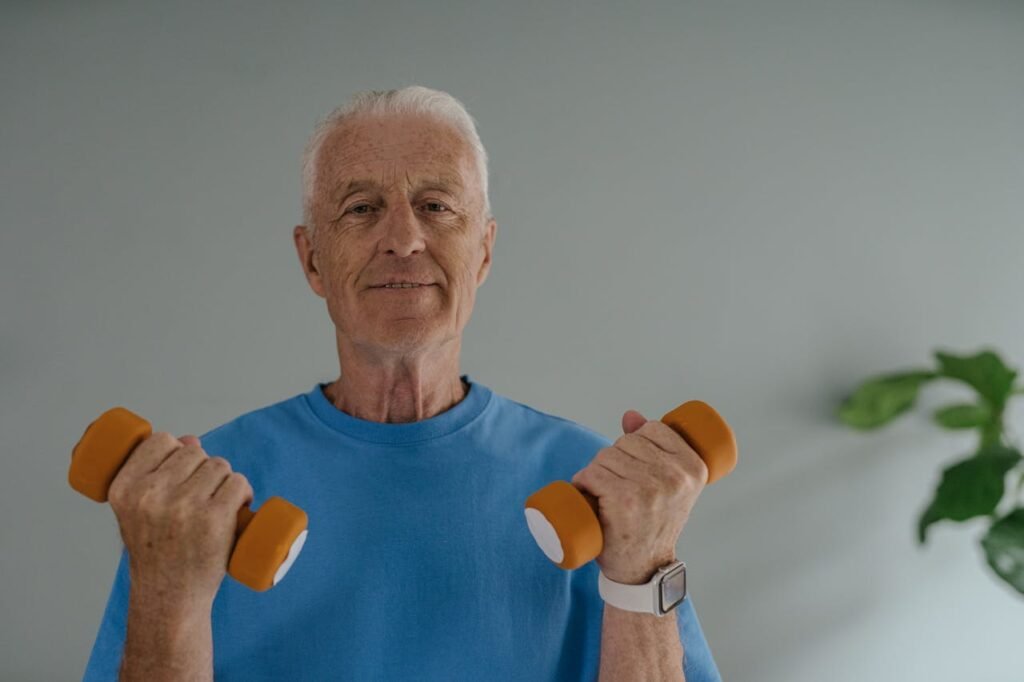Balance is something most of us never think about—until it starts to change. For seniors using prosthetics, keeping steady and confident while walking or moving can feel challenging at times. What many don’t realize is that balance doesn’t come from one single part of the body. It’s a beautiful teamwork between the eyes, ears, muscles, and brain.
When one sense weakens—like vision or hearing—the others have to work harder to keep everything in sync. For seniors with prosthetics, this delicate balance can become even more complex. The body needs to relearn how to stay centered, trust its footing, and coordinate movements smoothly.
The good news is, with the right awareness and small daily habits, this balance can be strengthened. You don’t need big workouts or advanced equipment—just an understanding of how your senses work together and how to support them gently.
In this guide, we’ll explore how vision, hearing, and prosthetic use connect to balance, why seniors sometimes feel unsteady, and what practical steps can help restore harmony between all three. You’ll discover how small lifestyle changes can create big improvements in movement confidence and overall wellbeing.
Understanding How Vision and Hearing Affect Balance in Seniors
How Vision Guides Balance
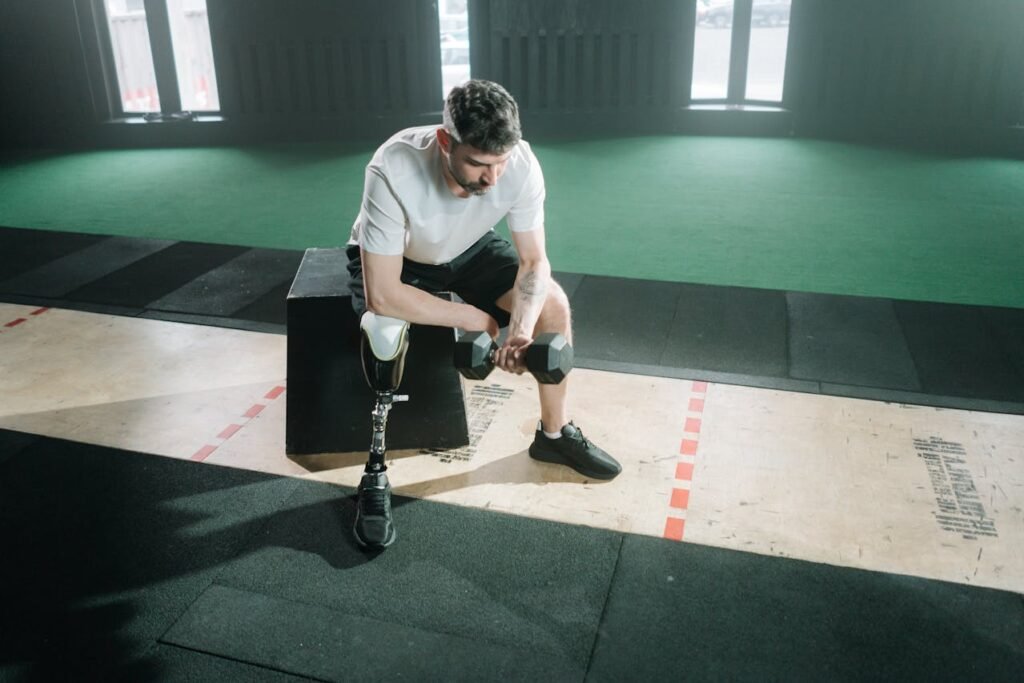
Vision is one of the most important senses for balance. Our eyes constantly send information to the brain about where we are in space. When seniors lose sharpness in sight—whether from cataracts, glaucoma, or normal aging—the brain receives fewer clear signals.
This makes it harder to judge distance, see uneven ground, or notice small obstacles. Seniors using prosthetics depend on visual feedback even more. They often rely on sight to check foot placement or hand grip. When vision weakens, confidence in movement naturally decreases.
Simple habits can help. Keeping rooms well-lit, using contrasting colors on floors, and ensuring glasses are updated can improve visual balance instantly. These are small but powerful steps that give the eyes more reliable information.
Peripheral Vision and Awareness
Peripheral vision—the ability to see from the corners of our eyes—helps us notice motion and changes around us. As people age, this field of view narrows. Seniors may not see objects approaching from the side or may turn too late to adjust balance.
For prosthetic users, this can increase the risk of bumping into objects or misjudging angles. Practicing gentle head-turning movements and ensuring wide, open spaces in the home allow the eyes to capture more information without strain.
The more the eyes can see, the better the body can plan each step.
How Hearing Supports Stability
Hearing also plays a quiet but powerful role in balance. Deep inside the ear is the vestibular system—a network of canals filled with fluid and hair-like sensors. These tiny structures send signals to the brain whenever the head tilts or turns.
When hearing loss occurs, or if there’s damage to the inner ear, this balance feedback becomes less accurate. Seniors may feel dizzy, light-headed, or unsure when walking, especially in dark or noisy spaces.
For seniors with prosthetics, this uncertainty can make each movement feel risky. They may hesitate before taking steps or avoid uneven surfaces altogether.
Recognizing Hearing-Related Balance Issues
It’s easy to miss early signs of hearing-linked imbalance. A senior might describe feeling “off” or “floaty,” especially when standing up quickly or turning around. They might lean slightly to one side or take wider steps for stability.
Hearing aids can help, but so can simple environmental changes. Reducing background noise, speaking clearly, and keeping surroundings quiet during movement all help the brain process spatial cues more effectively.
Seniors who feel dizzy should consult an audiologist or ENT specialist—sometimes, minor ear adjustments can make a huge difference in daily comfort.
How the Brain Combines Sight and Sound
Balance is really a conversation between the eyes, ears, and brain. The brain compares what it sees, what it hears, and what it feels through the body’s muscles and joints. When all three agree, movement feels effortless.
But if one system sends a confusing signal—like when vision blurs or the inner ear misfires—the brain struggles to interpret what’s happening. This confusion can cause hesitation or wobbling, especially in seniors adapting to prosthetic limbs.
Training these senses to cooperate again can rebuild stability. Gentle exercises that challenge both vision and hearing, such as walking while focusing on distant objects or practicing balance with background music, can help the body relearn coordination.
How Lighting and Sound Environments Affect Balance
The environment influences sensory balance more than most people realize. Dim lighting or echoing rooms make it harder for the brain to process where the body is. Seniors may feel less stable in dark hallways or noisy areas.
For those with prosthetics, these conditions make it tough to sense ground contact or limb position accurately. Improving light contrast, using soft floor mats, and minimizing echoes can instantly create a safer, steadier atmosphere.
When sight and sound are both supported, the prosthetic feels more like a natural extension rather than a foreign attachment.
The Role of Prosthetics in Multisensory Coordination
The Brain’s Adaptation to a Prosthetic
When a senior first starts using a prosthetic, the brain goes through a remarkable adjustment process. It must learn to interpret new signals from sensors, muscles, and touch. This process is called sensory integration.
In the early days, every movement feels deliberate. The brain focuses intensely on what used to happen automatically—walking, gripping, or balancing. Over time, with consistent practice, the brain rewires itself, blending prosthetic movement into natural motion.
This adaptation depends heavily on clear signals from vision and hearing. The more accurately the brain perceives the environment, the faster it learns to trust the prosthetic.
How Prosthetics Affect Balance
A prosthetic limb changes how weight is distributed. The body must learn a new way to stand, shift, and walk. For seniors, whose joints and muscles may already be weaker, this transition can be challenging.
The key lies in steady practice and sensory awareness. Feeling the floor through the prosthetic foot, watching each step carefully, and maintaining an upright posture all help restore equilibrium.
Modern prosthetics like those from RoboBionics are designed with natural weight balance and flexibility in mind, making this adjustment smoother.
Sense of Touch and Proprioception
The body’s ability to sense position and movement—called proprioception—is vital for balance. After amputation, this sense can weaken in the affected limb. Prosthetics that include tactile or pressure feedback systems help restore it.
RoboBionics’ patent-pending Sense of Touch™ technology allows users to feel subtle sensations through their prosthetic. This connection helps seniors judge grip strength, detect surfaces, and adjust their posture naturally.
By reawakening the sense of touch, prosthetic users regain confidence in their movements, even when vision or hearing isn’t perfect.
The Connection Between Sight and Prosthetic Use
Most seniors rely on visual cues when learning to use a prosthetic. They often look down at their limb to ensure proper placement. Over time, though, constant visual checking can strain the neck and create dependency.
Training to move without always looking at the prosthetic teaches the brain to rely more on body awareness. Simple exercises, like walking short distances while focusing forward, help build this confidence.
Vision then becomes a guide rather than a crutch, freeing the body to move more fluidly and safely.
The Sound of Movement
Sound can also play a helpful role in prosthetic training. Listening to the rhythmic tap of a footstep or the quiet hum of a prosthetic mechanism gives feedback about timing and balance.
For seniors with partial hearing, using hearing aids during practice helps them tune into these subtle sounds. Therapists sometimes use rhythmic cues like gentle music to guide walking pace, improving gait stability and confidence.
When vision, hearing, and motion work in rhythm, movement feels smoother and more natural.
Adapting the Inner Ear to New Movement
The inner ear is highly sensitive to changes in motion. When someone begins using a prosthetic, the head and body move differently than before. The vestibular system needs time to adjust to these new signals.
Slow, steady movement helps this adaptation. Turning the head gently while walking, maintaining eye contact with a fixed point, and pausing between steps allow the brain to recalibrate.
This coordination training may seem small, but it’s essential for long-term balance, especially for seniors.
Emotional Confidence and Sensory Balance
Physical balance is only half the story. Emotional balance plays an equally important role. Seniors who feel anxious or fearful of falling often stiffen their movements, which ironically increases imbalance.
Gamified rehabilitation, calm environments, and supportive prosthetic training all help reduce this fear. As confidence grows, so does fluidity. The brain relaxes, and the senses synchronize more naturally.
Emotional calm amplifies sensory harmony—it’s the hidden key to true balance.
Everyday Habits That Support Sensory Coordination
Daily habits can either strengthen or weaken sensory coordination. Simple routines—like maintaining consistent sleep, staying hydrated, and practicing mindfulness—keep the brain alert and responsive.
Seniors who stay socially engaged also show better sensory awareness. Conversations, music, and visual interaction keep all senses active. These small, consistent actions build a strong foundation for balance, making every movement safer and more confident.
Practical Balance Training for Seniors with Prosthetics
Visual Tuning Drills at Home
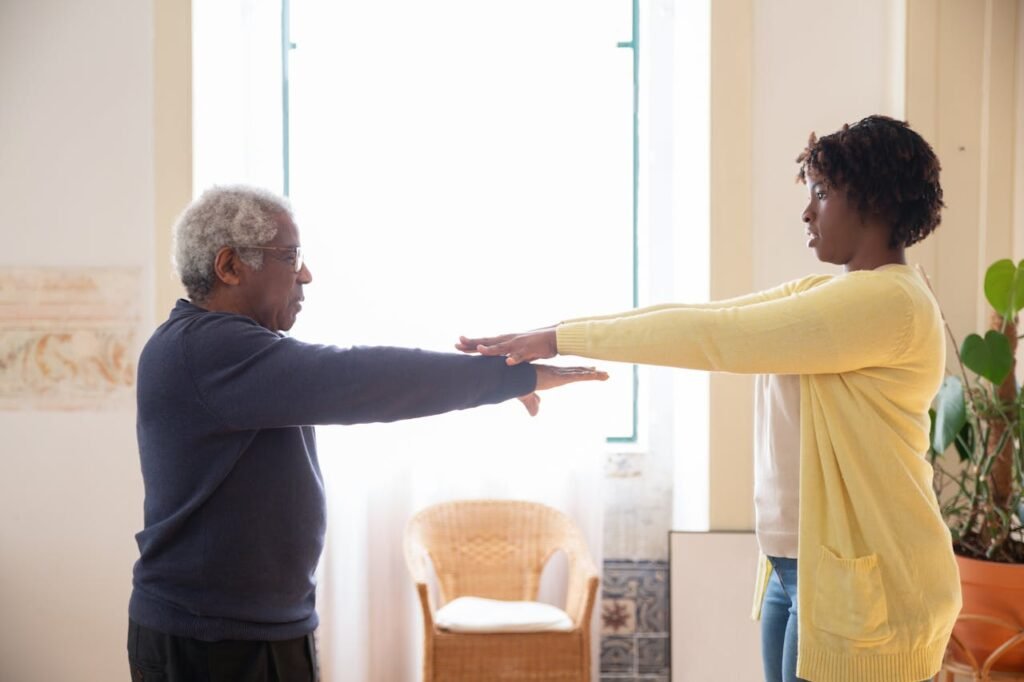
Start by training the eyes to guide the body. Stand near a sturdy chair and focus on a point at eye level across the room. Keep your gaze steady while shifting weight slowly from one foot to the other.
Then practice looking far, then near. Pick a distant object, then a nearby one on a table, and switch your focus every three breaths. This teaches the eyes to adjust quickly, which helps the brain plan each step.
Finish with gentle head turns. Keep the eyes on a fixed point while turning the head left and right. Move slowly, breathe evenly, and stop if you feel dizzy. This simple drill syncs eye and neck movement for smoother balance.
Hearing and Vestibular Calibration
Stand tall with feet hip-width apart. Close your eyes for a moment and listen to the room. Notice soft sounds—the fan, a clock, distant traffic. Open your eyes and repeat. You are teaching the brain to map space using sound.
Add a metronome or soft music with a steady beat. Step in place to the rhythm, heel to toe, without rushing. Rhythm reduces hesitation and gives the body a clear timing cue.
If you use hearing aids, keep them on during these drills. Clear, consistent sound gives your inner ear the steady feedback it needs to settle.
Rebuilding Proprioception Through Touch
Your skin, joints, and muscles are full of sensors. Wake them up with light touch. While seated, press the residual limb gently with a soft towel, moving from top to bottom. The brain learns the limb’s shape and position again.
Stand and use a fingertip on a wall or counter. The tiny touch gives the body a reference point without leaning. Over time, reduce the pressure and see if you can stand just as steady.
If you use the Grippy Bionic Hand, practice gentle gripping of soft objects like a sponge or stress ball. The tactile feedback trains grip control without strain.
Gait Rhythm and Safe Step Patterns
Begin with short, slow walks along a hallway. Look ahead, not down, and let the arms swing naturally. Count a simple pattern—one-two, one-two—to keep pace steady.
Practice step-over lines on the floor made with tape or a long scarf. Step high and place the foot carefully. This teaches the body to clear obstacles and trust the prosthetic’s movement.
When turning, take small steps in a circle rather than twisting. This reduces wobble, protects joints, and keeps the inner ear comfortable.
Training on Firm and Soft Surfaces
Start on a firm floor with shoes that grip well. When you feel steady, place a thin yoga mat nearby and try three controlled steps onto it. The slight give challenges your ankles and hips to adjust.
Hold a rail or countertop for the first attempts. Stay on the mat for only a few breaths, then return to the firm floor. Small doses of challenge build big reserves of balance over time.
Avoid thick, plush rugs early on. They hide edges and make the feet guess. Build skill first, then add complexity.
Using Light and Contrast for Stability
Good lighting is therapy. Place a lamp behind your shoulder when reading or crafting, not in front of your eyes. Reduce glare with warm bulbs and matte finishes.
Mark the first and last stair with bright tape. In the bathroom, use a contrasting bath mat against the floor color. These cues help the eyes judge depth and distance with less effort.
Keep pathways wide and clear, especially corners. Your peripheral vision will track the edges and guide you safely through.
Outdoor Navigation Skills
Begin on even pavements with clear lines or tiles. Scan the ground six to eight steps ahead, not just at your feet. This gives the brain time to plan.
Practice short slopes by leaning a little from the ankles, not the waist. Keep steps small, and use railings where possible. Build confidence in gentle weather before facing wind or rain.
If traffic noise is high, pause and let the sound settle before crossing. A quiet, focused brain keeps your body steady.
Sensory Exercises That Blend Sight, Sound, and Touch
Focus-Shift Standing Flow
Stand with your prosthetic foot slightly forward. Look at a point on the wall and breathe in for four counts. Shift weight toward the forward foot as you exhale for four counts.
Now change the gaze to a closer object, like a doorknob, and repeat the weight shift. The brain learns to balance while the eyes refocus, which mirrors real life.
Finish by lightly touching the wall with two fingers, then one, then none. Feel the body take over as the touch fades.
Seated Head and Eye Harmony
Sit upright with both feet planted. Keep the eyes on a card or sticky note at arm’s length. Slowly turn the head left and right while keeping the eyes glued to the card.
This drill strengthens the link between eye and neck muscles. It often reduces the woozy feeling some people get when turning quickly in stores or crowded rooms.
Do two or three rounds, resting as needed. Comfort first, then control.
Gentle Step and Reach
Stand beside a counter. Step forward with the prosthetic side and reach for a bright object on the counter with your opposite hand. Place it down, step back, and switch hands.
This diagonal pattern trains cross-body coordination—a key part of stable walking. It also teaches the eyes and hands to work together without rushing.
Keep the reach low and smooth. The goal is rhythm, not stretch.
Soft-Cue Grip Practice
Use a folded towel, a sponge, or a soft ball. If you use the Grippy Bionic Hand, adjust grip strength until it feels secure yet gentle. Grip for two counts, release for two counts.
Watch the object, then look away and continue by feel. This shifts control from sight to touch, which makes daily tasks faster and safer.
Over days, vary textures—soft, rubbery, slightly rough—so the brain learns different signals.
Daily Habits That Quietly Improve Balance
Morning Reset
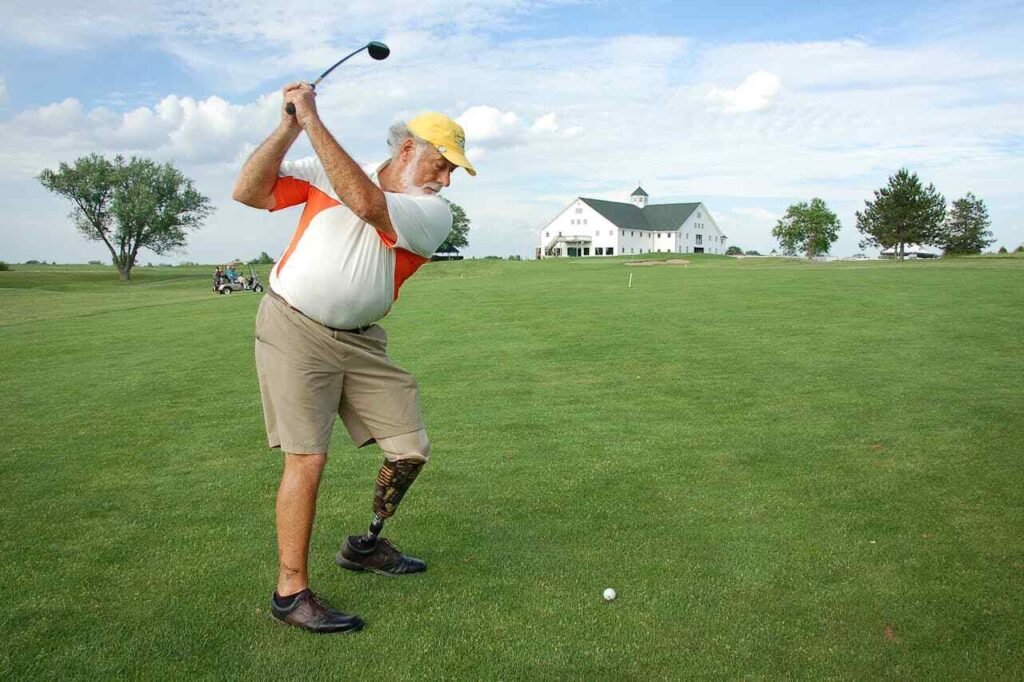
Begin each day with a hydration sip, then a one-minute stand-and-breathe. Feel both feet, lengthen the spine, and scan the room with calm eyes.
Add ten slow heel-to-toe shifts while holding a chair. This wakes the ankles, hips, and inner ear. The body starts the day organized and ready.
Check your glasses and hearing aids. Clear input equals clear movement.
Midday Motion Snack
Every few hours, do a short “motion snack.” Walk a loop around the room, touch a wall lightly, look far out a window, then focus on your hand.
These tiny resets keep the senses fresh. They prevent the slow creep of stiffness, which can cause stumbles later.
Pair the motion snack with a sip of water or buttermilk to keep the brain alert.
Evening Wind-Down
Dim overhead lights and use a warm lamp to reduce glare. Do seated head-and-eye harmony, then a slow stretch for calves and hamstrings.
Review your day. Notice one moment when balance felt good—a steady turn, a smooth reach, a confident step. Recognition strengthens the habit loop.
Set out tomorrow’s shoes and remove floor clutter. A tidy path is a gift to your senses.
Home Setup for Safer, Calmer Movement
Pathways and Floors
Keep walkways wide. Move side tables and footstools away from corners. The eyes love clean lines and open space.
Use low-pile rugs with non-slip backing or skip rugs entirely in early stages. Tape edges that might curl.
Place a night light on the route to the bathroom. The softer the shadows, the steadier the feet.
Seating and Surfaces
Choose chairs with firm seats and arms. They make standing easier and safer. Keep a stable table nearby for light hand support.
In the kitchen, place heavy items at waist height. Less bending means fewer sudden head movements, which keeps the inner ear happy.
Keep a small tray for daily tools—glasses, hearing aids, charger, and prosthetic care items—so nothing is missing when you need it.
Bathroom Confidence
Install a grab bar near the toilet and in the shower. Use a bench if standing feels tiring. Place a contrasting mat just outside the shower to guide foot placement.
Keep the mirror at eye level and lighting soft but clear. The brain steadies when it sees a calm, well-lit reflection.
Store towels within easy reach to avoid quick twists. Small changes reduce big risks.
Working With Your Prosthetic for Sensory Harmony
Fit, Comfort, and Routine Checks
A good socket fit is the base of balance. If you notice redness that lasts, pinching, or slipping, consult your prosthetist. Small adjustments prevent large compensations in posture.
Clean liners and check edges daily. Smooth materials help the skin send clean signals to the brain.
Create a simple donning routine. The same steps, the same order, every day. Routines calm the nervous system and improve control.
Visual Freedom Over Time
In the beginning, it’s normal to look down at the limb. Over weeks, practice looking forward while placing the foot with intention. Start with three steps, then five, then ten.
If you lose confidence, pause and reset your gaze on a steady object ahead. Let the body catch up before continuing.
Trust builds slowly and then becomes second nature.
Using Sound and Rhythm for Gait
Try a steady rhythm—a soft metronome or gentle instrumental track. Walk to the beat for two minutes, then rest.
The rhythm guides step timing and reduces hesitation. It also distracts from fear, which often causes stiff, shaky steps.
If using a hearing aid, keep background noise low so the rhythm remains clear.
Caregiver and Family Playbook
Calm Coaching, Not Pushing
Stand to the side, not in front. Offer a light touch at the elbow rather than pulling or steering. Let the senior set the pace and direction.
Use clear, simple cues: look ahead, small steps, breathe out. Words shape movement. Keep them few and kind.
Celebrate small wins—a smoother turn, a steady pause, a balanced reach. Recognition fuels progress.
Setting Up a Sensory-Friendly Day
Open curtains for natural light and keep rooms softly lit in the evening. Reduce echo with curtains or cushions if the room is loud.
Play quiet background music during walking practice. Choose steady rhythms, not fast beats. The goal is comfort, not speed.
Plan short sessions after meals, not before. A fed, hydrated brain balances better.
Safety Without Fear
Keep a discreet watch during new tasks—stairs, curbs, soft lawns. Be nearby, but let independence grow.
Agree on a simple signal for rest. If the senior feels wobbly, stop and sit. Recovery time is part of training.
Always end on a good note. The last memory of the session should be calm and steady.
When to Seek Extra Support
Signs You Should Not Ignore
New dizziness that lasts more than a day, sudden hearing changes, or strong headaches during movement need medical review. Do not wait these out.
If vision becomes blurry or double, or if you bump into doorframes more than once or twice, schedule an eye check. The fix might be as simple as updated lenses or better lighting.
If the prosthetic feels less stable, or the skin shows hot spots, contact your prosthetist. Early tweaks prevent setbacks.
Helpful Specialists
An audiologist can tune hearing aids and test vestibular function. A physiotherapist can design balance drills that match your strength. An occupational therapist can modify your home for safety without sacrificing comfort.
Share your daily routine and concerns openly. Clear stories help professionals find clear solutions.
Ask about combining therapy with gentle tech support—metronome cues, visual targets, or gamified rehab on a tablet. Small tools can make practice enjoyable.
Building Confidence in Real Life
Stairs, Curbs, and Crowds
Practice stairs with a rail and a helper first. Step up with the stronger side, down with the other. Pause after each step if needed. Steady beats steady.
At curbs, stand tall, look ahead, and place the foot with care. No rush. Traffic will wait for a sure step. Your safety comes first.
In busy places, move along the wall side. The extra visual boundary calms the brain and guides the body.
Markets, Temples, and Family Events
Choose times when crowds are thinner. Walk shorter loops at first, then lengthen as comfort grows. Keep water handy and rest in shade.
Invite a family member to be your “quiet partner.” Their job is to walk at your pace and share calm energy.
Every outing is practice for the senses. Each one builds the next.
Travel and Long Days
Break long days into short sessions of movement and rest. Stretch the calves, roll the shoulders, and sip water. Your inner ear and eyes love gentle resets.
Carry a small cloth to dry the liner or foot if weather is humid. Clean contact equals clean signals to the brain.
End the day with soft lighting, warm tea, and your evening wind-down. Recovery happens best in peace.
Gentle Strength and Flexibility for Better Balance
Core and Hips, The Quiet Stabilizers
Do seated marches: sit tall and lift one knee, then the other. Keep the belly light and the breath smooth. This wakes the hip flexors and core without strain.
Add standing hip shifts with a counter touch. Move the pelvis slightly left and right, keeping the chest quiet. Your body learns to manage weight without wobble.
Finish with a slow sit-to-stand from a firm chair. Eyes forward, exhale as you rise. This pattern powers daily life.
Ankles and Feet, The First Responders
Stand facing a wall, hands resting lightly. Rise onto the toes for two counts, then lower for two. Small range, full control.
Do gentle calf stretches with one foot back and the heel down. Feel the length, not the pull. Flexible calves reduce stumbles on slopes.
If your prosthetic allows, practice short weight shifts onto the forefoot, then the heel. This teaches the system to read the ground.
Nutrition, Hydration, and Sensory Clarity
Fuel for Focus
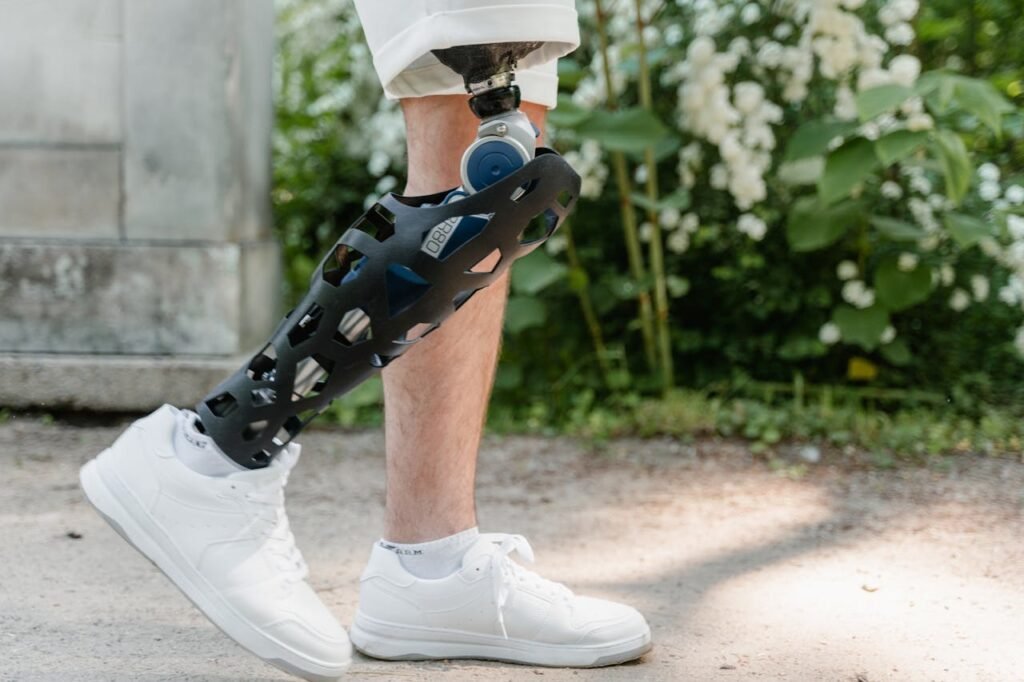
Eat regular, balanced meals with protein and colorful vegetables. Steady blood sugar keeps the eyes and inner ear happy.
Hydrate through the day, not all at once. Pale yellow urine is a simple sign that your body has what it needs.
Limit heavy meals before practice. A light belly balances better than a full one.
Calming Inflammation
Choose foods that soothe—turmeric in warm milk, ginger in soups, leafy greens with lemon. These help joints move easier and keep the mind clear.
If you take medications that dry the mouth or affect hearing, ask your doctor about timing them around practice. Small changes can bring big comfort.
Bringing It All Together With RoboBionics
Human-Centered Technology
Our Grippy Bionic Hand and Sense of Touch technology are built to restore trust between body and brain. Gentle feedback, natural grip, and reliable control help seniors move confidently.
Our gamified rehab app turns practice into play. It rewards focus, teaches rhythm, and builds skill without pressure. A few minutes a day can transform how movement feels.
Across India, we partner with care teams and families to make recovery warm, simple, and personal. Your journey guides our design.
Conclusion
The body balances best when senses agree
Stable movement comes from clear signals between eyes, ears, muscles, and mind. When vision and hearing are supported, the prosthetic feels natural, and each step grows lighter. Small, steady practice turns uncertainty into calm control.
Progress thrives on simple, daily habits
Short drills for gaze, rhythm, and touch build real confidence. Clean lighting, clear paths, and gentle routines reduce strain on the senses. With patience, the brain learns to trust new patterns and protect every movement.
Confidence grows with careful support
Regular checks with your prosthetist, eye care, and hearing care keep inputs sharp. A physiotherapist can shape safe balance work. Family guidance adds warmth and courage, so practice feels inviting, not hard.
Technology should feel like care
At RoboBionics, our Grippy Bionic Hand and Sense of Touch are designed to guide the body quietly. Our gamified rehab app turns practice into play, so learning is joyful and repeatable. Comfort and clarity lead every design choice we make.
Your next steady step starts today
Choose one drill, one tidy pathway, and one calm breath. Repeat tomorrow. Balance returns in quiet layers, and independence follows. If you’d like a personalised plan or a live walkthrough, book a free demo with our team at RoboBionics. We’ll help you build a gentle, multisensory routine that feels safe, simple, and strong.



